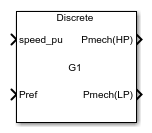Governor Type 1
IEEE type 1 linearized speed-governing steam turbine model
Libraries:
Simscape /
Electrical /
Control /
Turbine-Governors
Description
The Governor Type 1 block models a model IEEEG1 steam turbine-governor model IEEEG1.
This block allows the modeling of cross-compound units and it has two sets of turbine fractions:
LP Fraction, K_2, LP Fraction, K_4, LP Fraction, K_6, LP Fraction, K_8 for low-pressure (LP).
HP Fraction, K_1, HP Fraction, K_3, HP Fraction, K_5, HP Fraction, K_7 for high-pressure (HP).
You can switch between continuous and discrete implementations of the block by using the
Sample time (-1 for inherited) parameter. To configure the
governor for continuous time, set the Sample time (-1 for
inherited) property to 0. To configure the governor
for discrete time, set the Sample time (-1 for inherited) property
to a positive, nonzero value, or to -1 to inherit the sample time
from an upstream block.
This diagram illustrates the overall structure of the block:

Ports
Input
Output
Parameters
References
[1] Dynamic Models for Steam and Hydro Turbines in Power System Studies, IEEE Transactions on Power Apparatus and Systems. Vol. PAS-92, Number 6, 1973, pp. 1904–1915.
[2] Task Force on Turbine-Governor Modeling, Dynamic models for turbine-governors in power system studies, IEEE Power Energy Society, January 2013.
[3] IEEE Guide for the Application of Turbine Governor Systems for Hydroelectric Generating Units, IEEE Std 1207-2011.
Extended Capabilities
Version History
Introduced in R2020a
